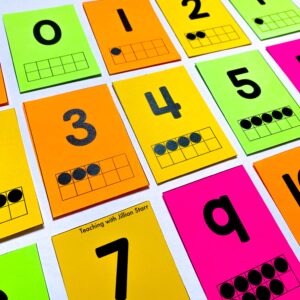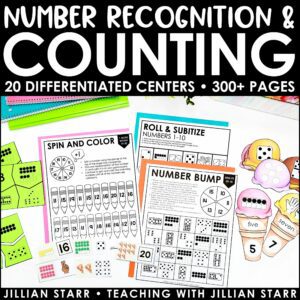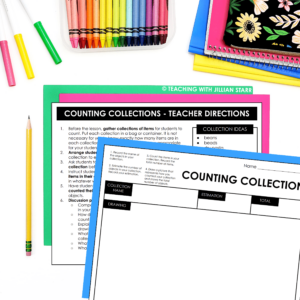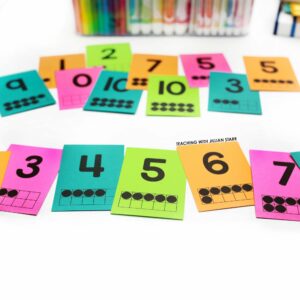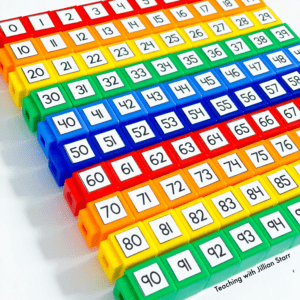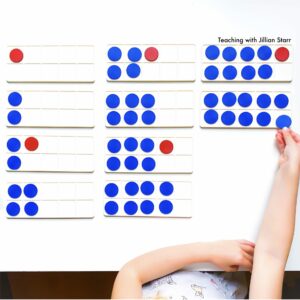
One of the most important foundational skills for young learners is number sense; the ability to understand and work with numbers flexibly. Developing strong number sense allows children to think critically about math, make connections between concepts, and solve problems in ways that make sense to them.
One simple, engaging tool that can have a big impact on building number sense is a clothesline! Yes, you read that right, something as simple as a clothesline can become a powerful math manipulative that helps students develop their understanding of number order, relationships, and estimation. In this article, we’ll explore how you can use clotheslines in your classroom to create interactive, meaningful math experiences that will help your students master essential number sense skills.
So what are we waiting for?! Let’s dive into the wonderful world of clothesline math!
What is Clothesline Math?
Clothesline math is an instructional strategy where a number line is represented by a physical clothesline strung across the classroom. Numbers, fractions, decimal numbers, or other math concepts are written on cards or slips of paper and hung on the line with clothespins. Students then work together or individually to place the cards in the correct order, based on the math concept being explored.
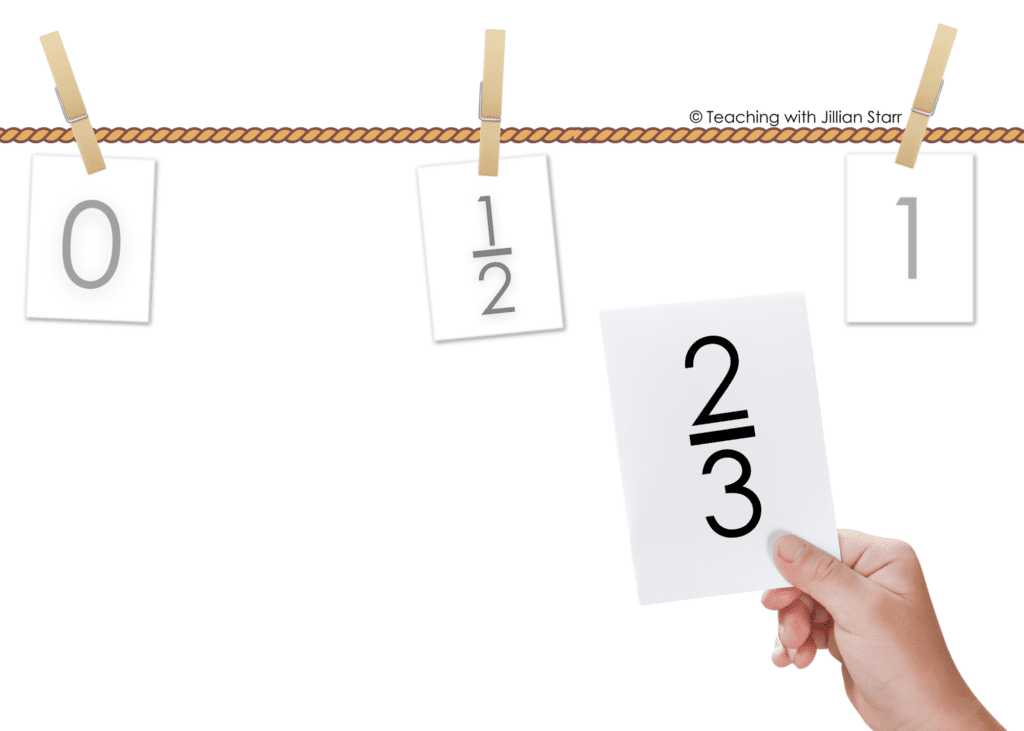
The great thing about clothesline math is that it turns abstract number lines into a tactile, visual, and interactive experience. Students can move the cards around, make adjustments, and discuss their thinking with one another, all of which promotes deep, flexible understanding of numbers.
Keep reading to learn about how clothesline math can be used to support math reasoning across the grade levels!
Builds Number Sense with Whole Numbers
Clotheslines are an excellent way to help students develop a strong sense of whole numbers and their relationships. Here are some ideas for using clotheslines to support number sense in your classroom:
Number Order and Sequencing:
For younger students who are learning to count and recognize numbers, you can hang number cards (1-20, for example) on the clothesline, but leave some numbers out. Ask students to identify which numbers are missing and place them in the correct order. This activity not only reinforces counting but also helps students practice sequencing and develop a sense of number magnitude.
Estimating and Placement:
As students get more comfortable with number order, you can make the task more challenging by hanging a few benchmark numbers, like 0, 10, 50, and/or 100 and asking students to place additional numbers on the line based on their position relative to the benchmark numbers. For example, if you hang cards for 0 and 100, students must decide where to place 25 or 75. This helps students develop an understanding of relative size and estimation.
Math Talks on the Clothesline:
Use the clothesline as a tool for math talks! Present a range of numbers on the clothesline and ask students questions like, “What do you notice about the placement of these numbers?” or “Where would the number 50 go on this line between 0 and 100?” These open-ended discussions encourage students to verbalize their thinking and reasoning, which strengthens their conceptual understanding.
Builds Number Sense with Fractions
Representing fractions on a number line can be complex for students to understand, but clotheslines offer a hands-on way to make sense of them. Students deepen their understanding of fractions as numbers by physically placing fraction cards on the line.
Fraction Placement:
Start by placing a few benchmark fractions, like 0, 1/2, and 1, on the clothesline. Then, challenge students to place other fractions, such as 1/4 or 3/4 in the correct spot. This helps students begin to conceptualize fractions as numbers and understand how different fractions relate to one another.
Equivalent Fractions:
Clotheslines are a fantastic way to explore equivalent fractions. Once students have placed fractions like 1/2, 1/4 and 3/4 on the line, introduce fractions like 2/4, 4/8, or 6/8 and ask them to place these numbers on the same line. This visual representation helps students grasp the concept of equivalence in a concrete way.
Comparing Fractions:
You can also use the clothesline to compare fractions by asking students to place fractions like 1/2, 2/3, and 3/5 in the correct order. Then, have a discussion about how you can tell which fractions are greater or less than others. This activity builds students’ understanding of fraction magnitude and deepens their number sense with non-whole numbers.
Promotes Estimation and Reasoning Skills
Clothesline math moves learning beyond just placing numbers in the right order. It’s also a great way to encourage estimation and reasoning skills. Asking students to estimate where a whole number or fraction belongs on the line helps them develop their ability to reason about numbers and make educated guesses.
Number Line Estimation:
Hang only a few numbers on the clothesline and ask students to place additional numbers based on estimation. For example, hang 0 and 10, and then ask students to place the number 7. This requires students to think carefully about the relative size of numbers and practice spatial reasoning.
Estimation with Fractions:
You can use the same strategy with fractions. For example, place 0 and 1 on the clothesline, and ask students to estimate where 2/3 belongs. This activity strengthens students’ understanding of number magnitude and their ability to reason about fractions.
Engages Students in Math Discussions
One of the most powerful aspects of clothesline math is that it naturally lends itself to rich math discussions. As students work together to place whole numbers or fractions on the line, they’ll engage in conversations about their reasoning and thinking. These discussions are invaluable for building math vocabulary, clarifying misconceptions, and deepening understanding.
Peer Collaboration:
Pair students up and have them work together to place numbers on the clothesline. As they collaborate, encourage them to explain their reasoning to each other. For example, if one student thinks that 1/3 should be placed before 1/4, ask them to explain why, and then encourage the other student to respond with their own reasoning. These discussions help students articulate their thinking and learn from each other.
Classroom Conversations:
After students have completed a clothesline activity, gather the class for a whole-group discussion. Ask questions like, “Why did you place this number here?” or “How do we know that this fraction is greater than that one?” These conversations encourage students to think critically about their decisions and give you insight into their thought processes.
Incorporating Clotheslines into Daily Math Routines
The great thing about clothesline math is that it’s incredibly versatile. You can use it as part of a lesson, during small group work, or even as a warm-up activity. Here are some ways to incorporate clothesline math into your daily routines:
Morning Math Challenge:
Start the day with a clothesline challenge! Hang a few whole numbers or fractions on the line, and have students work independently or in pairs to complete the sequence. This is a fun, low-pressure way to get students thinking about math when their brains are the most awake!
Math Centers:
Set up a clothesline math station as part of your math centers. Students can rotate through the station, working on number sequencing, fraction placement, or estimation. This hands-on activity is perfect for reinforcing key concepts while giving students the opportunity to explore math at their own pace.
Assessment Tool:
Clothesline activities can also be used as a formative assessment tool. When you observe how students interact with the clothesline and listen to their discussions, you can gain valuable insight into their understanding of number sense concepts and identify any areas where they may need additional support.
Using a clothesline in your math classroom is a simple yet powerful way to support number sense development. Whether you’re working with whole numbers or fractions, the interactive and visual nature of clothesline math helps students make connections, deepen their understanding, and build confidence in their math skills.
So grab some string, clothespins, and a stack of notecards, and watch your students get excited about building number sense in a whole new way!

